Volume 23, No. 2 – February 2010

Upcoming Program: Wednesday, February 10, 2010
Before retiring in 2005, Robert Schuldenfrei was an international
consultant, specializing in computer-based logistical systems.
For 20 years he owned and ran S. I. Inc.
Over his career, he participated in two successful start-ups –
consulting businesses established, developed, then sold.
He h as published numerous articles over the years on the general
theme of business logistics.
Robert holds an AB in economics from Syracuse University and an MBA from
Amos Tuck School, Dartmouth University.
His topic will be: Manna From Heaven – Northern Supply 1861-62, telling the remarkable
story, still largely unreported, of how the Union harnessed its massive
productive engine to win the Civil War; how it utilized technology,
information and some very competent people to focus its strengths and
prevail on the battlefield. This
represents the birth of management science that will play an
increasingly important role in both industrial and military operations.
President’s Message
PLEASE REMEMBER: DUES ARE DUE NOW.
January 13, 2010 Meeting
Election of Officers, Other Business
The
President stated: “The system of setting up a Board of Directors is not
working. I suggest that the membership simply elect three top officials,
President, Treasurer and Secretary.
If and when a good candidate for Vice President surfaces, the
members can simply elect one.” By
a show of hands, the members present almost unanimously approved the
President’s suggested change in procedure.
Accordingly, upon motion duly made and seconded, the following
persons were unanimously re-elected: President – Gerridine LaRovere,
Treasurer – Robert Krasner, and Secretary – Stephen L. Seftenberg.
The President noted that we needed people to fill work on
recruiting speakers and encouraging donation of food and beverages.
Upon motion duly made and seconded, the President’s commitment of
$200 to our April 2010 speaker, Robert Bonekemper, was unanimously
approved.
Robert Schenkel Remembered
On a
sad note, the President advised the members that a veteran member,
Robert Schenkel, has died. Since
no one seems to know the names or address of his kin, this month’s
Newsletter will be sent to Robert’s old address in hopes it will be
forwarded to his relatives, who will get in touch with the Roundtable.
Also, those who wish to make a contribution to Battlefield
Preservation can send a check to Stephen L. Seftenberg, 2765 White Wing
Lane, West Palm Beach, FL 33409, or give it to him at the February
meeting.
Answers to the December Quiz:
-
When
slavery was abolished in Washington, D. C., in 1862, slave owners
were paid $300.00 for
each freed slave.
-
Frederick Douglass’ home in Washington, D. C. (now a National
Historic Site) was Cedar Hill.
-
Jefferson Davis appointed a succession of unsuccessful generals in
the West to avoid appointing
P. G. T. Beauregard.
-
Judah P. Benjamin held three Cabinet positions:
Secretary of War, Attorney
General and Secretary of State.
-
A
famous English relative of Judah P. Benjamin was Benjamin Disraeli,
1st Earl of Beaconsfield, KG, PC, FRS
-
The
Gamble Mansion is located in
Ellenton, Florida.
Second Seminole War Battlefield in Jupiter to be
Preserved
Leland Smith, who in addition to being one of the earliest members
of the Roundtable, is also a leading member of the Sons of Union
Veterans of the Civil War (successor to the Grand Old Army), brought
to our attention an important event, held Saturday, January 16, 2010
in Riverbend Park, Jupiter: a Black Seminole Battlefield Memorial
Ceremony presented by the Loxahatchee Battlefield Preservationists
and the Florida Black Historical Research Project. The event
commemorated all those who died during the Second Seminole War
Battles along the Loxahatchee River, January 15 and 24, 1838.
The principal speaker was be Richard J. Procyk, author of
“Guns across the Loxahatchee,” an archaeohistorical investigation of
Seminole War sites in Florida, with special focus on the Battle of
Loxahatchee, January 24, 1838.
Leland related that the group has obtained a $40,000 grant to
be used toward preserving the battlefield.
Foreigners in the Civil War: Why They Came and
Why They Fought
| Census |
Population |
Immigrants |
Foreign Born |
Percentage |
| 1790 |
3,918,000 |
60,000 |
|
|
| 1800 |
5,236,000 |
60,000 |
|
|
| 1810 |
7,036,000 |
60,000 |
|
|
| 1820 |
10,086,000 |
60,000 |
|
|
| 1830 |
12,785,000 |
143,000 |
200,000 |
1.60% |
| 1840 |
17,018,000 |
599,000 |
800,000 |
4.70% |
| 1850 |
23,054,000 |
1,713,000 |
2,244,000 |
9.70% |
| 1860 |
27,490,000 |
3,954,000 |
4,136,173 |
15.10% |
|
|
|
|
|
| The “Immigrants” figures for
1790-1820 and the |
|
| “Foreign Born” figures for 1830-1840
are estimates |
Dr.
Marsha Sonnenblick first warned us that in 1860 the term “Native
American” did not mean “American Indian” but “American Born.”
The adjacent table shows
the mounting
wave of immigration, beginning in 1830s. Immigration was met by
mounting opposition, led and fed by the “Know Nothing Party,” which was
primarily aimed at Roman Catholic immigrants. It was not only Catholics:
Maryland, in 1830, was the first state to permit Jews to hold public
office! The table below shows the proportion of the total population
consisting of “foreign born” persons from various countries.
Of some historical interest is the paucity of immigration from
Italy and Poland, which came after 1900.
The Irish Wave
|
Origins of Free Population 1860 census |
| Country |
Total |
|
| British
America |
249,970 |
|
| China |
35,565 |
|
| England |
431,692 |
|
| German
States |
1,301,136 |
|
| Holland |
26,281 |
|
| Ireland |
1,611,304 |
|
| Italy |
10,513 |
|
| Poland |
7,298 |
|
| Scotland |
106,518 |
|
|
Switzerland |
53,327 |
|
| Wales |
43,763 |
|
| Total |
4,136,173 |
|
Following the 1848 Potato Famine in Ireland, “coffin ship” after coffin
ship arrived in New York. Mortality on the trips exceeded 25%.
Advertisements for jobs routinely stated, “No Irish Need Apply.”
The Irish settled in the “Five Points” neighborhood, the backdrop
for the movie “Gangs of New York,” which quickly became a squalid slum.
The Church by default became the “binding force” for the Irish,
and with it involvement in local politics.
As a group, the Irish were
pro slavery and anti
abolitionist (freed slaves would compete for jobs), but they were
also pro Union, at least until
the Emancipation Proclamation and the Draft Riots in New York.
The Irish did volunteer, especially when offered a $300 bonus to
sign up (equivalent to a year’s wages!).
Dr.
Sonnenblick than compared the stories of three Irish “heroes,” Thomas
Francis Meagher, Michael Corcoran and Patrick Ronayne Cleburne .
 Thomas
Francis Meagher (1823-1867), pronounced “Marh”, favored Irish
independence and gained fame as “Meagher of the Sword” for a speech
urging war. In 1848, he was
convicted of sedition. His death
sentence was commuted to penal transportation to Tasmania.
In 1852, he escaped to the United States, studied law, worked as
a journalist, lectured on the
Irish cause and became a captain in the Irish Militia.
When the Civil War broke out, even though he was sympathetic to
the South, he opposed slavery and
recruited a full company of infantrymen (Company K) to be attached to
the 69th Infantry Regiment, New York State Volunteers, which under Col.
Michael Corcoran fought bravely at First Bull Run.
Meagher then raised the Irish Brigade and was named its leader,
thus becoming another of Lincoln’s “political generals” noted more for
their political power than their ability as a general.
His troops did fight fiercely at the Battle of Fair Oaks (June 1,
1862) and he became famous because of a Currier and Ives print
depicting him leading his brigade in a bayonet charge (which may or may
not have happened). At the Battle
of Antietam (September 17, 1862), he was injured because he was
allegedly drunk and fell off his horse.
He was supposedly wounded at Fredericksburg and left his troops
leaderless. His brigade suffered over 90% casualties in these battles.
He resigned his commission in May 1863 because the Army refused
to let him return to New York to raise reinforcements.
In December 1863, his resignation was rescinded and he was
assigned to the Western Theater.
After the war, Meager was rewarded by appointment as Acting Governor of
the Territory of Montana. He died
July 1, 1867 when he fell overboard from a steamer on the Missouri River
under somewhat mysterious circumstances.
His legend has grown and a monument was erected in his honor at
Antietam battlefield, a statute was erected on the Capitol grounds in
Helena, Montana, and in 2004 a statute of Meagher on horseback, with
sword raised, was erected in his home city, Waterford, Ireland. Thomas
Francis Meagher (1823-1867), pronounced “Marh”, favored Irish
independence and gained fame as “Meagher of the Sword” for a speech
urging war. In 1848, he was
convicted of sedition. His death
sentence was commuted to penal transportation to Tasmania.
In 1852, he escaped to the United States, studied law, worked as
a journalist, lectured on the
Irish cause and became a captain in the Irish Militia.
When the Civil War broke out, even though he was sympathetic to
the South, he opposed slavery and
recruited a full company of infantrymen (Company K) to be attached to
the 69th Infantry Regiment, New York State Volunteers, which under Col.
Michael Corcoran fought bravely at First Bull Run.
Meagher then raised the Irish Brigade and was named its leader,
thus becoming another of Lincoln’s “political generals” noted more for
their political power than their ability as a general.
His troops did fight fiercely at the Battle of Fair Oaks (June 1,
1862) and he became famous because of a Currier and Ives print
depicting him leading his brigade in a bayonet charge (which may or may
not have happened). At the Battle
of Antietam (September 17, 1862), he was injured because he was
allegedly drunk and fell off his horse.
He was supposedly wounded at Fredericksburg and left his troops
leaderless. His brigade suffered over 90% casualties in these battles.
He resigned his commission in May 1863 because the Army refused
to let him return to New York to raise reinforcements.
In December 1863, his resignation was rescinded and he was
assigned to the Western Theater.
After the war, Meager was rewarded by appointment as Acting Governor of
the Territory of Montana. He died
July 1, 1867 when he fell overboard from a steamer on the Missouri River
under somewhat mysterious circumstances.
His legend has grown and a monument was erected in his honor at
Antietam battlefield, a statute was erected on the Capitol grounds in
Helena, Montana, and in 2004 a statute of Meagher on horseback, with
sword raised, was erected in his home city, Waterford, Ireland.
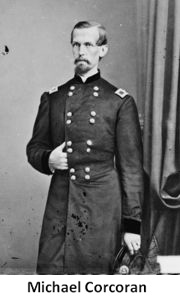 Michael
Corcoran
(1827-1863), an entirely different kettle of fish, emigrated to the U.
S. in 1849 and worked in a tavern. He became active in Democratic
politics and could deliver the Irish vote. He enlisted as a private in
the 69th and in 1859 was appointed its colonel.
On October 11, 1861, he refused to march his men in a parade in
honor of the 19-year old Prince of Wales.
His courts-martial trial was dropped and he was restored to
command of the 69th. At First
Bull Run he was wounded and captured.
The U. S. Navy had captured a Confederate privateer called the
“Enchantress” and threatened to execute its crew.
The Confederates responded by threatening to execute U. S.
prisoners in retaliation. No
executions ever took place.
Corcoran declined parole (which would have prevented him from rejoining
his brigade) and was eventually exchanged in August 1862.
He became the leader of the “Corcoran Legion,” 8 Irish regiments.
He served in several battles but on December 22, 1863, while
riding alone, his horse fell on him and he died from a fractured skull.
Corcoran was idolized by his Irish-American troops.
In 2006 a monument to the Fighting 69th was erected in Ballymore,
Ireland. Michael
Corcoran
(1827-1863), an entirely different kettle of fish, emigrated to the U.
S. in 1849 and worked in a tavern. He became active in Democratic
politics and could deliver the Irish vote. He enlisted as a private in
the 69th and in 1859 was appointed its colonel.
On October 11, 1861, he refused to march his men in a parade in
honor of the 19-year old Prince of Wales.
His courts-martial trial was dropped and he was restored to
command of the 69th. At First
Bull Run he was wounded and captured.
The U. S. Navy had captured a Confederate privateer called the
“Enchantress” and threatened to execute its crew.
The Confederates responded by threatening to execute U. S.
prisoners in retaliation. No
executions ever took place.
Corcoran declined parole (which would have prevented him from rejoining
his brigade) and was eventually exchanged in August 1862.
He became the leader of the “Corcoran Legion,” 8 Irish regiments.
He served in several battles but on December 22, 1863, while
riding alone, his horse fell on him and he died from a fractured skull.
Corcoran was idolized by his Irish-American troops.
In 2006 a monument to the Fighting 69th was erected in Ballymore,
Ireland.
 Many
Irish immigrants and Irish-Americans fought for the Confederacy.
Perhaps the best known of them was
Patrick Ronayne Cleburne
(1828 – 1864). Born in County
Cork, Ireland, Cleburne served in the 41st Regiment of Foot of the
British Army after failing to gain entrance into Trinity College of
Medicine. He emigrated to Arkansas where he started out as a pharmacist
but soon became a skilled lawyer and politician. At the beginning of the
Civil War, Cleburne sided with the Southern States, equating the North
and England. He never owned a slave. He progressed from being a private
soldier in the local militia to a division commander. One of two foreign
born officers to attain the rank of major general in the Confederate
armed forces, he distinguished himself in many battles, especially the
Battle of Stones River and the Battle of Ringgold Gap. His strategic
ability gained him the nickname "Stonewall of the West."
He was killed in 1864, in the Battle of Franklin.
After he proposed using freed slaves as Confederate soldiers,
President Davis picked other, less able generals to lead the Confederate
armies in the West. Sadly, no
statute has ever been erected in his memory. Many
Irish immigrants and Irish-Americans fought for the Confederacy.
Perhaps the best known of them was
Patrick Ronayne Cleburne
(1828 – 1864). Born in County
Cork, Ireland, Cleburne served in the 41st Regiment of Foot of the
British Army after failing to gain entrance into Trinity College of
Medicine. He emigrated to Arkansas where he started out as a pharmacist
but soon became a skilled lawyer and politician. At the beginning of the
Civil War, Cleburne sided with the Southern States, equating the North
and England. He never owned a slave. He progressed from being a private
soldier in the local militia to a division commander. One of two foreign
born officers to attain the rank of major general in the Confederate
armed forces, he distinguished himself in many battles, especially the
Battle of Stones River and the Battle of Ringgold Gap. His strategic
ability gained him the nickname "Stonewall of the West."
He was killed in 1864, in the Battle of Franklin.
After he proposed using freed slaves as Confederate soldiers,
President Davis picked other, less able generals to lead the Confederate
armies in the West. Sadly, no
statute has ever been erected in his memory.
The German Wave
The Germans came in large numbers, but they were a
different demographic than the Irish: intellectuals, Marxists, skilled
workers, largely literate, family members.
However, they spoke a “strange” language and faced the same
discrimination (especially discriminated against were the 50,000 to
150,000 Jews). As a result
they organized civic, religious organizations, read many German-language
newspapers. In St. Louis
alone they set up 25 beer breweries!
They had left Germany because of political oppression and wanted
political freedom. They
opposed slavery,
in part on moral grounds and in part because they
did not feel threatened by competition from freed slaves.
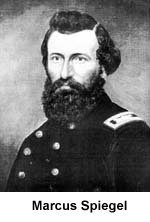 Marcus Spiegel
fled Germany after the failure of the Revolution
of 1848. His parents had preceded
him to Chicago,
where he became a peddler. While
visiting the home of a Quaker in Ohio, he met and married his host’s
daughter, Caroline Frances Hamlin.
Spiegel set up business in Ohio, became active in the Democratic
Party, supported Stephen A. Douglas, “The Little Giant,” in the 1860
election. Originally apathetic about slavery, he was totally
committed to the cause of preserving the Union.
He was one of the few Jews who rose to high command.
He distinguished himself at the Battle of Vicksburg, where a
statute of him was later erected. He was killed in a minor skirmish in
Louisiana in 1864. Of note, his
brother founded the Spiegel Catalogue. Marcus Spiegel
fled Germany after the failure of the Revolution
of 1848. His parents had preceded
him to Chicago,
where he became a peddler. While
visiting the home of a Quaker in Ohio, he met and married his host’s
daughter, Caroline Frances Hamlin.
Spiegel set up business in Ohio, became active in the Democratic
Party, supported Stephen A. Douglas, “The Little Giant,” in the 1860
election. Originally apathetic about slavery, he was totally
committed to the cause of preserving the Union.
He was one of the few Jews who rose to high command.
He distinguished himself at the Battle of Vicksburg, where a
statute of him was later erected. He was killed in a minor skirmish in
Louisiana in 1864. Of note, his
brother founded the Spiegel Catalogue.
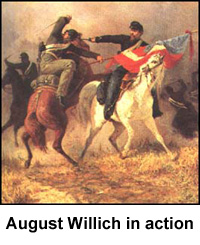 Brigadier General
August Willich (1810-1878)
was arguably the best brigadier in the 20th Corps and among the best in
the Union army in 1863. A dedicated Communist; the fifty-three year old
former Prussian Army
Lieutenant had forsaken his first career to pursue political reform,
supporting himself through carpentry.
While living in England, his involvement with Karl Marx’s wife
led to his challenge to Marx to a duel (Marx evaded this test of his
manhood)! When the war came,
his military experience and ardent anti-slavery leanings propelled him
back into uniform. As did so
many other German civic leaders, he raised the 32nd Indiana Regiment (an
all-German regiment). Brigadier General
August Willich (1810-1878)
was arguably the best brigadier in the 20th Corps and among the best in
the Union army in 1863. A dedicated Communist; the fifty-three year old
former Prussian Army
Lieutenant had forsaken his first career to pursue political reform,
supporting himself through carpentry.
While living in England, his involvement with Karl Marx’s wife
led to his challenge to Marx to a duel (Marx evaded this test of his
manhood)! When the war came,
his military experience and ardent anti-slavery leanings propelled him
back into uniform. As did so
many other German civic leaders, he raised the 32nd Indiana Regiment (an
all-German regiment).
Willich drilled his regiment, in German. It made a favorable impression
wherever it served. An innovative officer, he suggested construction of
special wagons convertible to pontoon boats by removing of wheels. To
speed up troop movement and assure combat condition of troops upon
arrival at the battle-field, he recommended wagon transport of troops.
His superiors rejected both ideas. Yet, Willich's concern for his men's
well-being earned him the nickname "Papa". When possible, he ordered
bakery ovens constructed that troops would have fresh bread.
The 32nd saw action at the Battle of Shiloh, during which Col.
Willich displayed inspiring bravery. When his troops became unsteady, he
stood before them, his back to
the enemy, and conducted the regiment through the manual of arms. He
also had the regimental band play 'La Marseillaise', which was the
anthem for all republican movements in Europe. Recovering its nerves,
the 32nd launched a bayonet attack and he was promoted to Brig. General.
During the Siege of Chattanooga, Willich's Brigade captured
Orchard Knob, and assaulted up
Missionary Ridge and were the first to reach the top! Due to the
anti-German sentiment in the nation, and the army in particular,
veterans of the 32nd did not re-enlist when their three year enlistments
expired. Nor did most other all-German regiments. It rankled the
German-American soldier that General Joseph Hooker had blamed German
troops of the 11th Corps for his defeat at Chancellorsville. The New
York Times unfairly labeled the 11th Corps "Dutch Cowards."
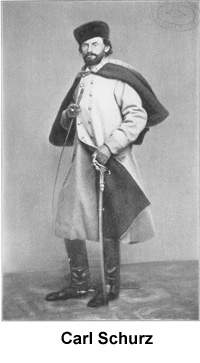 Carl Schurz (1829-1906) became involved in radical politics
and the Revolution of 1848.
After fleeing to Switzerland,
Schurz reached the United States in1852, ending up in Wisconsin.
His wife founded the
first kindergarten in the United States.
He was an active abolitionist and campaigned for Lincoln in 1860. He was appointed Ambassador
to Spain and was effective in keeping Spain from recognizing the
Confederacy. He could be called a
“political” general but he proved to be an adept student of war and an
effective leader. After fighting in Second Bull Run and Fredericksburg,
he was promoted to major general.
He was also involved in the battles of Chancellorsville and Gettysburg.
After the war he became a well-respected journalist and writer.
In 1872, he was elected to the U. S. Senate from Missouri, and in
1877 he was appointed Secretary of the Interior, where he introduced
civil service reforms and improved the Bureau of Indian Affairs (which
needed it badly). Carl Schurz (1829-1906) became involved in radical politics
and the Revolution of 1848.
After fleeing to Switzerland,
Schurz reached the United States in1852, ending up in Wisconsin.
His wife founded the
first kindergarten in the United States.
He was an active abolitionist and campaigned for Lincoln in 1860. He was appointed Ambassador
to Spain and was effective in keeping Spain from recognizing the
Confederacy. He could be called a
“political” general but he proved to be an adept student of war and an
effective leader. After fighting in Second Bull Run and Fredericksburg,
he was promoted to major general.
He was also involved in the battles of Chancellorsville and Gettysburg.
After the war he became a well-respected journalist and writer.
In 1872, he was elected to the U. S. Senate from Missouri, and in
1877 he was appointed Secretary of the Interior, where he introduced
civil service reforms and improved the Bureau of Indian Affairs (which
needed it badly).
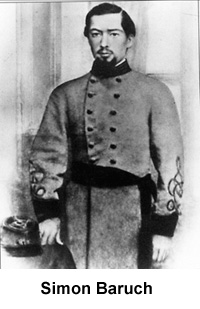 Simon Baruch
(1840-1921) was born to a Jewish family living in
Prussia. After studying medicine, he had a driving ambition to practice
medicine, a profession that was closed to him in his native land.
He emigrated to the South Carolina and began a successful
practice in the antebellum South with the help of local Jewish
physicians. He graduated from the Medical College of Virginia in 1862.
When the Civil War started, Baruch joined the Confederate Army
under General Robert E. Lee and was assigned as a surgeon in the field
with the rank of Captain. "South Carolina gave me all I have," he said
at the time, "I'll go with my state."
In the Battle of Bull Run after the Confederate troops withdrew,
Dr. Baruch was left in charge of threescore wounded men and was captured
with the wounded men, by the Union troops.
After several months’ imprisonment he was exchanged rejoined the
Confederate army. In the Battle of Gettysburg he was again taken
prisoner while attending to the wounded. He was sent to Fort McHenry.
While in a Federal war prison he wrote a book on gunshot wounds.
After the war he resumed a highly acclaimed practice, first in
South Carolina and then in New York City.
He played a leading role in improving military medical services
in World War I. He is quoted as
having said: There are no such things as incurable, there are only
things for which man has not found a cure.”
One of his four sons was Bernard M. Baruch. Simon Baruch
(1840-1921) was born to a Jewish family living in
Prussia. After studying medicine, he had a driving ambition to practice
medicine, a profession that was closed to him in his native land.
He emigrated to the South Carolina and began a successful
practice in the antebellum South with the help of local Jewish
physicians. He graduated from the Medical College of Virginia in 1862.
When the Civil War started, Baruch joined the Confederate Army
under General Robert E. Lee and was assigned as a surgeon in the field
with the rank of Captain. "South Carolina gave me all I have," he said
at the time, "I'll go with my state."
In the Battle of Bull Run after the Confederate troops withdrew,
Dr. Baruch was left in charge of threescore wounded men and was captured
with the wounded men, by the Union troops.
After several months’ imprisonment he was exchanged rejoined the
Confederate army. In the Battle of Gettysburg he was again taken
prisoner while attending to the wounded. He was sent to Fort McHenry.
While in a Federal war prison he wrote a book on gunshot wounds.
After the war he resumed a highly acclaimed practice, first in
South Carolina and then in New York City.
He played a leading role in improving military medical services
in World War I. He is quoted as
having said: There are no such things as incurable, there are only
things for which man has not found a cure.”
One of his four sons was Bernard M. Baruch.
Representing other Nationalities
Welsh miners dug the ill-fated tunnel under the Confederate
fortifications at Petersburg in 1864 and were similarly employed on many
other fronts.
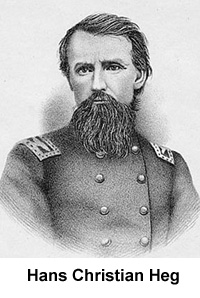 Hans Christian Heg
(1829-1863) was born in
Norway and came to Racine, Wisconsin with his parents.
He
was a Major in the 4th Wisconsin Militia, the State Prison Commissioner
(the first Norwegian elected to a Wisconsin state-wide office), and an
out-spoken anti-slavery activist when he was appointed by Wisconsin
Governor Alexander Randall to be the Colonel (commander) of the 15th
Wisconsin Regiment. Both men were members of the recently formed
Republican party and the ancient order of Freemasons. At that time he
was 32 years old, married, and the father of 3 children. Colonel Heg
recruiting efforts were very successful, spurring enlistments by
Norwegian, Danish, and Swedish immigrants living in the States of
Wisconsin, Illinois, Iowa, and Minnesota. He participated with valor in
the capture of Island No. 10, the battle of Franklin (where he was
wounded) and the Battle of Stones River. Promoted and put in charge of a
Division, Heg was fatally wounded at the Battle of Chickamauga,
September 19, 1863. He was
described thus: “His bravery, demonstrated in many engagements, is
unquestioned. It is not however, the reckless daring of an unskilled and
careless man, but the cool and determined valor of a competent,
thoughtful commander. He is prudent, but not timid; deliberate, but not
slow in movement.” Hans Christian Heg
(1829-1863) was born in
Norway and came to Racine, Wisconsin with his parents.
He
was a Major in the 4th Wisconsin Militia, the State Prison Commissioner
(the first Norwegian elected to a Wisconsin state-wide office), and an
out-spoken anti-slavery activist when he was appointed by Wisconsin
Governor Alexander Randall to be the Colonel (commander) of the 15th
Wisconsin Regiment. Both men were members of the recently formed
Republican party and the ancient order of Freemasons. At that time he
was 32 years old, married, and the father of 3 children. Colonel Heg
recruiting efforts were very successful, spurring enlistments by
Norwegian, Danish, and Swedish immigrants living in the States of
Wisconsin, Illinois, Iowa, and Minnesota. He participated with valor in
the capture of Island No. 10, the battle of Franklin (where he was
wounded) and the Battle of Stones River. Promoted and put in charge of a
Division, Heg was fatally wounded at the Battle of Chickamauga,
September 19, 1863. He was
described thus: “His bravery, demonstrated in many engagements, is
unquestioned. It is not however, the reckless daring of an unskilled and
careless man, but the cool and determined valor of a competent,
thoughtful commander. He is prudent, but not timid; deliberate, but not
slow in movement.”
The
Swedish engineer,
John Ericsson, revolutionized
naval history with his invention of the screw propeller.
Ericsson was also the designer of the USS
Monitor, the ship that ensured
Union naval supremacy during the
Civil War. His memorial sculpture
is located in Washington, D. C.
Wladimir B. Krzyaznowski [Wlodzimierz Bonawentura
Krzyzanowski]
(1814-1887) a first cousin of Frederick Chopin, took part in the 1846
uprising against Prussia and fled from
Poland to avoid arrest. He
settled in Virginia, became a railroad builder.
He enlisted in the Union Army, raised a brigade of Polish
immigrants, called the “Polish Legion.” In the Battle of Gettysburg his
troops helped push back an evening assault by the famed Louisiana Tigers
on the Union defenses atop East Cemetery Hill.
After the war, he was appointed as the military governor of
Florida, Georgia and Alabama during Reconstruction.
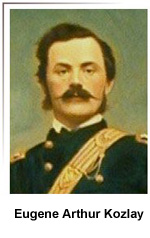 Eugene
Arthur Kozlay (1826-1883), born in
Hungary, recruited many
German immigrants from Brooklyn and New York City to form the 54th
Infantry Regiment (NY), which after many battles, took part in the
defense of Cemetery Hill at the Battle of Gettysburg. Eugene
Arthur Kozlay (1826-1883), born in
Hungary, recruited many
German immigrants from Brooklyn and New York City to form the 54th
Infantry Regiment (NY), which after many battles, took part in the
defense of Cemetery Hill at the Battle of Gettysburg.
Hong Neok Woo (1824-1919) reputedly was the only
Chinese to serve in the Civil
War. Born in China, he reached
the U. S. in 1855, was sworn in as a U. S. citizen in 1860 (one of the
very few) and served as a private in a Pennsylvania regiment 1861-1864.
Emile Frei
(1838-1922), was born in
Switzerland, came to Illinois, served in the Union Army, was
captured in the Battle of Gettysburg and served 18 months in Libby
Prison before being exchanged.
After the war, he returned to Switzerland and in 1894 was elected
President of the Swiss Confederation!
 Henry Wirz (1823-1865) was born in
Switzerland, emigrated to Kentucky in 1849 and
established a successful medical practice.
When the Civil War broke out Wirz
claimed to have enlisted as a
private in Company A, Fourth-Battalion, Louisiana Volunteers and took
part in the Battle of Seven Pines in May 1862, during which he was
wounded and lost the use of his right arm. Because of his injury, Wirz
was assigned to the staff of General John Winder, who was in charge of
Confederate prisoner of war camps. In February, 1864, the Confederate
government established Camp Sumter, a large military prison near the
small railroad depot at Anderson, Georgia, to house Union prisoners of
war. In March, Wirz took command of Camp Sumter where he remained for
over a year. Though wooden
barracks were originally planned, the Confederates incarcerated the
prisoners in a vast, rectangular, open-air stockade originally
encompassing sixteen and a half acres,
which had been intended as only a
temporary prison pending exchanges of prisoners with the North,
which the North had stopped doing
in order to defeat the South by attrition. The prisoners
themselves dubbed the camp Andersonville. The prison suffered an extreme
lack of food, tools and medical supplies, severe overcrowding, poor
sanitary conditions and a lack of potable water. At its peak in August
1864, the camp held approximately 32,000 Union prisoners, making it the
fifth largest city in the Confederacy. The monthly mortality rate from
disease and malnutrition reached 3000. Around 45,000 prisoners were
incarcerated during the camp's 14-month existence, of whom 13,000 (28%)
died. After the Civil War, the
Union tried Wirz for war crimes on account of his alleged cruelties at
the Andersonville prison camp.
Wirz's trial was the first war-crimes trial in U.S. history and the only
trial for war crimes of a Confederate.
He was convicted in what can only be called a “show” trial and
hung. Henry Wirz (1823-1865) was born in
Switzerland, emigrated to Kentucky in 1849 and
established a successful medical practice.
When the Civil War broke out Wirz
claimed to have enlisted as a
private in Company A, Fourth-Battalion, Louisiana Volunteers and took
part in the Battle of Seven Pines in May 1862, during which he was
wounded and lost the use of his right arm. Because of his injury, Wirz
was assigned to the staff of General John Winder, who was in charge of
Confederate prisoner of war camps. In February, 1864, the Confederate
government established Camp Sumter, a large military prison near the
small railroad depot at Anderson, Georgia, to house Union prisoners of
war. In March, Wirz took command of Camp Sumter where he remained for
over a year. Though wooden
barracks were originally planned, the Confederates incarcerated the
prisoners in a vast, rectangular, open-air stockade originally
encompassing sixteen and a half acres,
which had been intended as only a
temporary prison pending exchanges of prisoners with the North,
which the North had stopped doing
in order to defeat the South by attrition. The prisoners
themselves dubbed the camp Andersonville. The prison suffered an extreme
lack of food, tools and medical supplies, severe overcrowding, poor
sanitary conditions and a lack of potable water. At its peak in August
1864, the camp held approximately 32,000 Union prisoners, making it the
fifth largest city in the Confederacy. The monthly mortality rate from
disease and malnutrition reached 3000. Around 45,000 prisoners were
incarcerated during the camp's 14-month existence, of whom 13,000 (28%)
died. After the Civil War, the
Union tried Wirz for war crimes on account of his alleged cruelties at
the Andersonville prison camp.
Wirz's trial was the first war-crimes trial in U.S. history and the only
trial for war crimes of a Confederate.
He was convicted in what can only be called a “show” trial and
hung.
Dr.
Sonnenblick closed her stimulating talk by answering many questions.
A wonderful evening!
Last changed: 08/09/10
Home
About
News
Newsletters
Calendar
Memories
Links
Join
|

